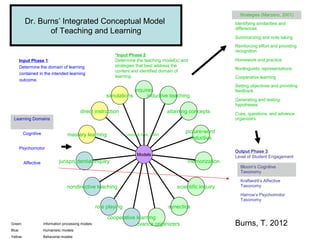
Conceptual Model Of Teaching And Learning
- 1. Strategies (Marzano, 2001) Dr. Burns’ Integrated Conceptual Model Identifying similarities and differences of Teaching and Learning Summarizing and note taking Reinforcing effort and providing recognition *Input Phase 2: Input Phase 1: Determine the teaching model(s) and Homework and practice Determine the domain of learning strategies that best address the Nonlinguistic representations content and identified domain of contained in the intended learning learning. Cooperative learning outcome. Setting objectives and providing inquires feedback simulations inductive teaching Generating and testing hypotheses direct instruction attaining concepts Cues, questions, and advance Learning Domains organizers Cognitive picture-word mastery learning (Joyce & Weil, 2000) inductive Psychomotor Output Phase 3: Models Level of Student Engagement Affective jurisprudential inquiry memorization Bloom’s Cognitive Taxonomy Kraftwohl’s Affective nondirective teaching scientific inquiry Taxonomy Harrow’s Psychomotor Taxonomy role playing synectics cooperative learning Green: Information processing models advance organizers Burns, T. 2012 Blue: Humanistic models Yellow: Behavorial models
